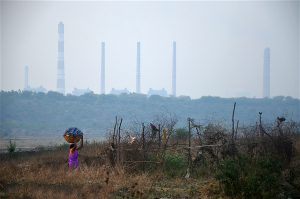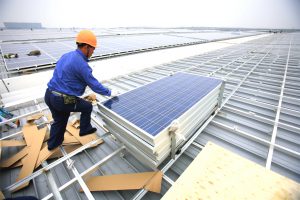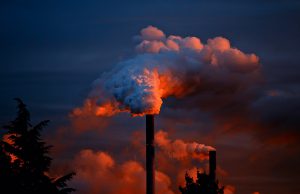In the global drive to fight climate change, the West has long been viewed as pioneering while developing nations are often stigmatised as laggards. But this conventional wisdom is now under attack following US President Donald Trump’s announcement that his government would withdraw from the Paris accord. Later that day, the Chinese government reaffirmed its commitment to the agreement.
With the US on the way out of the agreement, does this mean that China will become the world’s environmental leader? Many analysts think so, and media outlets from the New York Times to the National Geographic have dedicated column inches making such a case.
However, while it is true that China has the capacity to lead on climate change, it is unlikely to fill the void left by the US. Its ability to consistently deliver on its environmental pledges is not guaranteed because there is a gap between what the central government demands and what actually happens on the ground.
Beijing has invested much political capital and financial clout into environmental initiatives to sooth domestic frustration with pollution and impress other world powers. For example, the power sector, which together with manufacturing, accounts for more than 80% of the country’s total carbon emissions, has undergone a surprising about-face, with renewables (hydro, wind and solar) generating about 153 terawatt hours (TWh) in 2016. This record almost matches Germany’s impressive 186 TWh of renewable-generated power.
The International Energy Agency estimates that coal will remain the biggest source of electricity generation until at least 2040, and consumption in South and East Asia is projected to rise. China will remain the largest consumer in the world.
‘Greening’ coal power
China’s efforts to “green” coal, the country’s dominant source of energy, are a critical part of the nation’s new environmental drive. Beijing has already set emissions and efficiency standards for coal-fired power plants higher than either the EU or the US. The government requires new power plants to emit no more than 50 milligrammes of nitrogen oxide per cubic metre. These standards are much looser in the US (95 mg/m3) and the EU (150 mg/m3).
Ultra-supercritical coal power plant technology is also expected to help plants meet stricter standards. These plants ignite coal at a much higher temperature (1400°F) and higher internal pressure levels (more than 5,000 pounds per square inch) than traditional subcritical plants, which allows them to generate electricity more efficiently. According to a recent report by the Center for American Progress (CAP), Beijing has made far more strides than Washington on this front, as more than 90% of China’s 100 most efficient coal plants are equipped with ultra-supercritical technologies, compared with only 0.76% in the US.
Beijing is also undertaking other measures to help reinforce the efficiency gains that accompany upgrades to supercritical plants. In the production stream, coal pulverisation and large-scale fluidised bed boilers are popular innovations. In addition, Beijing has encouraged the development of the coal-to-chemicals industry by investing in coal pyrolysis, gasification, and carbon capture and storage (CCS) technologies. CCS has the capacity to trap and store up to 90% of CO2 emissions from electricity generation and industrial processes in geological reservoirs such as depleted oil and gas fields and un-mineable coal seams. Luckily for Beijing, it is comparatively easier to add CCS to an ultra-supercritical plant than a subcritical or supercritical one.
Regional differences
It’s clear that China’s efforts to green its coal-fired plants are far ahead of those in the US. But Beijing is still a long way from being a global clean energy role model, largely because of unmitigated cross-regional differences in energy development and carbon emissions. When it comes to China, there is always more than meets the eye.
In many ways, China has the right political, geopolitical, and economic conditions to steer the country’s energy policy towards a cleaner path. For instance, the government’s “clean coal” initiatives stem in large part from the ruling party’s efforts to address middle class anger with pollution. What’s more, demonstrating a willingness to slash carbon emissions through cutting-edge technologies helps reinforce the legitimacy of the Chinese Communist Party, which is based on the twin principles of economic performance and social harmony. Unfortunately, the government’s top-down approach of imposing emission quotas and efficiency standards is inherently flawed, since it leaves considerable room for non-compliance among different plants and in different regions.
For instance, it takes an additional 20-30% in upfront costs to install ultra-high-efficiency low-emission (HELE) technologies. Whereas big plants that enjoy government subsidies can easily absorb the cost, smaller producers find the burden harder to shoulder. As a result, less-efficient subcritical plants still make up 48% of the country’s coal-fired plants. In addition to wide technological discrepancies among plants, there is also a large gap in energy efficiency levels between less developed, coal-producing provinces, like Inner Mongolia and Ningxia, and more developed coastal areas. Such critical regional discrepancies undermine the image of conformity Beijing is trying to show the world. More polluting regions are often caught in a dilemma between meeting Beijing’s environmental objectives and satisfying local demands for growth and employment.
Hope for coal yet
Despite these kinds of gaps, the Chinese example is a hopeful one. It showcases to other nations that the route to sustainability does not need to be phrased as a zero-sum game, pitting renewables versus coal.
Like China, India has been successfully following a transitional path to clean energy. The country generates 72% of its electricity from coal and its government takes a pragmatic stance on energy, seeing both coal and renewables as indispensable in the country’s pursuit of development. To provide power for the 300 million Indians who currently have no access to electricity while still meeting Paris agreement targets, India has been employing CCS to use coal in the most sustainable way. One Indian firm has been capturing carbon from its coal-powered boiler and using it to make baking soda. Additionally, the Indian government has put HELE on the agenda. It plans to upgrade 40 gigawatts with supercritical technology and develop an 800-megawatt power plant with ultra-supercritical boilers by 2020.
More developed countries are also pursuing the use of clean coal technologies. The world’s third-largest coal producer, Australia, is expected to meet its Paris climate goals by replacing existing coal power stations with ultra-supercritical ones, thereby reducing carbon emissions by 28%. Japan, the world’s fourth-largest coal consumer, has installed two HELE coal units at the Isogo thermal power station with an efficiency rate of 45%. These were constructed to account for the loss of nuclear power capacity after the 2011 earthquake.
With Beijing not yet at the point of becoming a global role model, it might be up to states like India, Japan, and Australia, which are pursuing pragmatic energy efficiency policies while avoiding China’s top-down approach, to help fill the energy policy void left by Washington.





![A newly built water tank on top of the Srinagar Hill in Palpa, western Nepal [image by: Abhaya Raj Joshi]](https://dialogue.earth/content/uploads/2017/07/water-tank-in-Srinagar-300x172.jpg)

